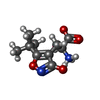+ データを開く
データを開く
- 基本情報
基本情報
| 登録情報 | データベース: PDB / ID: 1nnk | ||||||
|---|---|---|---|---|---|---|---|
| タイトル | X-ray structure of the GluR2 ligand-binding core (S1S2J) in complex with (S)-ATPA at 1.85 A resolution. Crystallization with zinc ions. | ||||||
 要素 要素 | Glutamate receptor 2 | ||||||
 キーワード キーワード | MEMBRANE PROTEIN / Ionotropic glutamate receptor GluR2 / ligand-binding core / agonist complex | ||||||
| 機能・相同性 |  機能・相同性情報 機能・相同性情報spine synapse / dendritic spine neck / dendritic spine head / cellular response to amine stimulus / perisynaptic space / Activation of AMPA receptors / ligand-gated monoatomic cation channel activity / AMPA glutamate receptor activity / response to lithium ion / Trafficking of GluR2-containing AMPA receptors ...spine synapse / dendritic spine neck / dendritic spine head / cellular response to amine stimulus / perisynaptic space / Activation of AMPA receptors / ligand-gated monoatomic cation channel activity / AMPA glutamate receptor activity / response to lithium ion / Trafficking of GluR2-containing AMPA receptors / kainate selective glutamate receptor activity / AMPA glutamate receptor complex / cellular response to glycine / extracellularly glutamate-gated ion channel activity / immunoglobulin binding / asymmetric synapse / ionotropic glutamate receptor complex / conditioned place preference / regulation of receptor recycling / glutamate receptor binding / Unblocking of NMDA receptors, glutamate binding and activation / positive regulation of synaptic transmission / regulation of synaptic transmission, glutamatergic / response to fungicide / cytoskeletal protein binding / glutamate-gated receptor activity / regulation of long-term synaptic depression / extracellular ligand-gated monoatomic ion channel activity / cellular response to brain-derived neurotrophic factor stimulus / glutamate-gated calcium ion channel activity / presynaptic active zone membrane / somatodendritic compartment / dendrite membrane / ionotropic glutamate receptor binding / ligand-gated monoatomic ion channel activity involved in regulation of presynaptic membrane potential / ionotropic glutamate receptor signaling pathway / dendrite cytoplasm / synaptic membrane / dendritic shaft / SNARE binding / transmitter-gated monoatomic ion channel activity involved in regulation of postsynaptic membrane potential / synaptic transmission, glutamatergic / PDZ domain binding / protein tetramerization / establishment of protein localization / postsynaptic density membrane / cerebral cortex development / modulation of chemical synaptic transmission / receptor internalization / Schaffer collateral - CA1 synapse / terminal bouton / synaptic vesicle / synaptic vesicle membrane / presynapse / signaling receptor activity / amyloid-beta binding / presynaptic membrane / growth cone / scaffold protein binding / perikaryon / dendritic spine / chemical synaptic transmission / postsynaptic membrane / neuron projection / postsynaptic density / axon / external side of plasma membrane / neuronal cell body / synapse / dendrite / protein kinase binding / protein-containing complex binding / glutamatergic synapse / cell surface / endoplasmic reticulum / protein-containing complex / identical protein binding / membrane / plasma membrane 類似検索 - 分子機能 | ||||||
| 生物種 |  | ||||||
| 手法 |  X線回折 / X線回折 /  シンクロトロン / シンクロトロン /  分子置換 / 解像度: 1.85 Å 分子置換 / 解像度: 1.85 Å | ||||||
 データ登録者 データ登録者 | Lunn, M.-L. / Hogner, A. / Stensbol, T.B. / Gouaux, E. / Egebjerg, J. / Kastrup, J.S. | ||||||
 引用 引用 |  ジャーナル: J.Med.Chem. / 年: 2003 ジャーナル: J.Med.Chem. / 年: 2003タイトル: Three-Dimensional Structure of the Ligand-Binding Core of GluR2 in Complex with the Agonist (S)-ATPA: Implications for Receptor Subunit Selectivity. 著者: Lunn, M.L. / Hogner, A. / Stensbol, T.B. / Gouaux, E. / Egebjerg, J. / Kastrup, J.S. #1:  ジャーナル: J.Mol.Biol. / 年: 2002 ジャーナル: J.Mol.Biol. / 年: 2002タイトル: Structural basis for AMPA receptor activation and ligand selectivity: Crystal structures of five agonist complexes with the GluR2 ligand binding core. 著者: Hogner, A. / Kastrup, J.S. / Jin, R. / Liljefors, T. / Mayer, M.L. / Egebjerg, J. / Larsen, I. / Gouaux, E. #2:  ジャーナル: Neuron / 年: 2000 ジャーナル: Neuron / 年: 2000タイトル: Mechanisms for activation and antagonism of an AMPA-sensitive glutamate receptor: Crystal structures of the GluR2 ligand binding core. 著者: Armstrong, N. / Gouaux, E. #3:  ジャーナル: Nature / 年: 2002 ジャーナル: Nature / 年: 2002タイトル: Mechanism of glutamate receptor desensitization. 著者: Sun, Y. / Olson, R. / Horning, M. / Armstrong, N. / Mayer, M. / Gouaux, E. #4:  ジャーナル: Protein Sci. / 年: 1998 ジャーナル: Protein Sci. / 年: 1998タイトル: Probing the ligand binding domain of the GluR2 receptor by proteolysis and deletion mutagenesis defines domain boundaries and yields a crystallizable construct. 著者: Chen, G.Q. / Sun, R. / Jin, R. / Gouaux, E. | ||||||
| 履歴 |
| ||||||
| Remark 300 | BIOMOLECULE: 1 THIS ENTRY CONTAINS THE CRYSTALLOGRAPHIC ASYMMETRIC UNIT WHICH CONSISTS OF 1 ... BIOMOLECULE: 1 THIS ENTRY CONTAINS THE CRYSTALLOGRAPHIC ASYMMETRIC UNIT WHICH CONSISTS OF 1 CHAIN(S). SEE REMARK 350 FOR INFORMATION ON GENERATING THE BIOLOGICAL MOLECULE(S). NOTE THAT COORDINATES FOR ONE DIMER OF THE TETRAMERIC MULTIMER REPRESENTING THE KNOWN BIOLOGICALLY SIGNIFICANT OLIGOMERIZATION STATE OF THE MOLECULE CAN BE GENERATED BY APPLYING BIOMT TRANSFORMATIONS GIVEN IN REMARK 350. | ||||||
| Remark 999 | SEQUENCE Native GluR2 is a membrane protein. The protein crystallized is the extracellular ligand- ...SEQUENCE Native GluR2 is a membrane protein. The protein crystallized is the extracellular ligand-binding core of GluR2. Transmembrane regions were genetically removed and replaced with a Gly-Thr linker (residues 115-116). Therefore, the sequence matches discontinuously with the reference database (413-527, 653-796). The two first residues of the sequence (Gly-2, Ala-1) are cloning artifacts and were not located in the electron density map. |
- 構造の表示
構造の表示
| 構造ビューア | 分子:  Molmil Molmil Jmol/JSmol Jmol/JSmol |
|---|
- ダウンロードとリンク
ダウンロードとリンク
- ダウンロード
ダウンロード
| PDBx/mmCIF形式 |  1nnk.cif.gz 1nnk.cif.gz | 72.5 KB | 表示 |  PDBx/mmCIF形式 PDBx/mmCIF形式 |
|---|---|---|---|---|
| PDB形式 |  pdb1nnk.ent.gz pdb1nnk.ent.gz | 52.2 KB | 表示 |  PDB形式 PDB形式 |
| PDBx/mmJSON形式 |  1nnk.json.gz 1nnk.json.gz | ツリー表示 |  PDBx/mmJSON形式 PDBx/mmJSON形式 | |
| その他 |  その他のダウンロード その他のダウンロード |
-検証レポート
| アーカイブディレクトリ |  https://data.pdbj.org/pub/pdb/validation_reports/nn/1nnk https://data.pdbj.org/pub/pdb/validation_reports/nn/1nnk ftp://data.pdbj.org/pub/pdb/validation_reports/nn/1nnk ftp://data.pdbj.org/pub/pdb/validation_reports/nn/1nnk | HTTPS FTP |
|---|
-関連構造データ
- リンク
リンク
- 集合体
集合体
| 登録構造単位 | 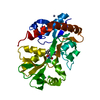
| ||||||||
|---|---|---|---|---|---|---|---|---|---|
| 1 | 
| ||||||||
| 単位格子 |
| ||||||||
| 詳細 | The biological assembly is a tetramer composed of dimers-of-dimers. Only the dimer is observed in the crystal. The dimer may be generated by applying the following to chain A: TRANSFORM FRACTIONAL - -1.00000 0.00000 0.00000 - 0.00000 -1.00000 0.00000 - 0.00000 0.00000 1.00000 - 2.00000 0.00000 0.00000 |
- 要素
要素
| #1: タンパク質 | 分子量: 29221.682 Da / 分子数: 1 / 断片: GluR2-flop ligand-binding core (S1S2J) / 由来タイプ: 組換発現 / 由来: (組換発現)   | ||||||||
|---|---|---|---|---|---|---|---|---|---|
| #2: 化合物 | | #3: 化合物 | ChemComp-CL / | #4: 化合物 | ChemComp-CE2 / | #5: 水 | ChemComp-HOH / | Has protein modification | Y | |
-実験情報
-実験
| 実験 | 手法:  X線回折 / 使用した結晶の数: 1 X線回折 / 使用した結晶の数: 1 |
|---|
- 試料調製
試料調製
| 結晶 | マシュー密度: 2.4 Å3/Da / 溶媒含有率: 49 % | ||||||||||||||||||||||||||||||||||||
|---|---|---|---|---|---|---|---|---|---|---|---|---|---|---|---|---|---|---|---|---|---|---|---|---|---|---|---|---|---|---|---|---|---|---|---|---|---|
| 結晶化 | 温度: 279 K / 手法: 蒸気拡散法, ハンギングドロップ法 / pH: 5.5 詳細: zinc acetate, cacodylate, PEG8000, pH 5.5, VAPOR DIFFUSION, HANGING DROP, temperature 279K | ||||||||||||||||||||||||||||||||||||
| 結晶化 | *PLUS 温度: 6 ℃ | ||||||||||||||||||||||||||||||||||||
| 溶液の組成 | *PLUS
|
-データ収集
| 回折 | 平均測定温度: 100 K |
|---|---|
| 放射光源 | 由来:  シンクロトロン / サイト: シンクロトロン / サイト:  MAX II MAX II  / ビームライン: I711 / 波長: 1.0835 Å / ビームライン: I711 / 波長: 1.0835 Å |
| 検出器 | タイプ: MARRESEARCH / 検出器: CCD / 日付: 2001年3月14日 |
| 放射 | モノクロメーター: NULL. / プロトコル: SINGLE WAVELENGTH / 単色(M)・ラウエ(L): M / 散乱光タイプ: x-ray |
| 放射波長 | 波長: 1.0835 Å / 相対比: 1 |
| 反射 | 解像度: 1.85→20 Å / Num. all: 23016 / Num. obs: 23016 / % possible obs: 92.6 % / Observed criterion σ(F): 0 / Observed criterion σ(I): 0 / 冗長度: 3.5 % / Biso Wilson estimate: 18.2 Å2 / Rmerge(I) obs: 0.099 / Net I/σ(I): 7 |
| 反射 シェル | 解像度: 1.85→1.92 Å / Rmerge(I) obs: 0.34 / Mean I/σ(I) obs: 2 / Num. unique all: 1996 / % possible all: 82.1 |
| 反射 | *PLUS 最低解像度: 20 Å |
| 反射 シェル | *PLUS % possible obs: 82.1 % / Rmerge(I) obs: 0.34 |
- 解析
解析
| ソフトウェア |
| ||||||||||||||||||||||||||||||||||||
|---|---|---|---|---|---|---|---|---|---|---|---|---|---|---|---|---|---|---|---|---|---|---|---|---|---|---|---|---|---|---|---|---|---|---|---|---|---|
| 精密化 | 構造決定の手法:  分子置換 分子置換開始モデル: GluR2:(S)-thio-ATPA complex (Lunn et al., to be published). 解像度: 1.85→19.99 Å / Rfactor Rfree error: 0.009 / Data cutoff high rms absF: 1449707.81 / Isotropic thermal model: RESTRAINED / 交差検証法: THROUGHOUT / σ(F): 0 / 立体化学のターゲット値: Engh & Huber 詳細: The first three N-terminal residues and the last two C-terminal residues were not located in the electron density map.
| ||||||||||||||||||||||||||||||||||||
| 溶媒の処理 | 溶媒モデル: FLAT MODEL / Bsol: 48.7733 Å2 / ksol: 0.418009 e/Å3 | ||||||||||||||||||||||||||||||||||||
| 原子変位パラメータ | Biso mean: 27.4 Å2
| ||||||||||||||||||||||||||||||||||||
| Refine analyze |
| ||||||||||||||||||||||||||||||||||||
| 精密化ステップ | サイクル: LAST / 解像度: 1.85→19.99 Å
| ||||||||||||||||||||||||||||||||||||
| 拘束条件 |
| ||||||||||||||||||||||||||||||||||||
| LS精密化 シェル | 解像度: 1.85→1.97 Å / Rfactor Rfree error: 0.029 / Total num. of bins used: 6
| ||||||||||||||||||||||||||||||||||||
| Xplor file | Serial no: 1 / Param file: protein_rep.param / Topol file: protein.top | ||||||||||||||||||||||||||||||||||||
| 精密化 | *PLUS 最低解像度: 20 Å / % reflection Rfree: 2.7 % | ||||||||||||||||||||||||||||||||||||
| 溶媒の処理 | *PLUS | ||||||||||||||||||||||||||||||||||||
| 原子変位パラメータ | *PLUS | ||||||||||||||||||||||||||||||||||||
| 拘束条件 | *PLUS
|
 ムービー
ムービー コントローラー
コントローラー














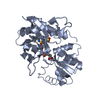









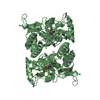
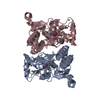





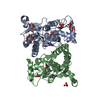
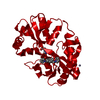

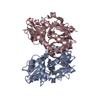

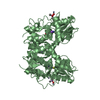



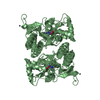
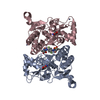

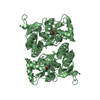
 PDBj
PDBj








